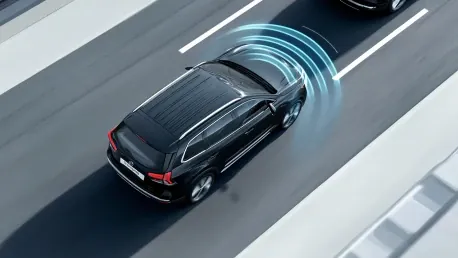The Connected Car Market is a burgeoning sector within the automotive industry characterized by vehicles equipped with Internet access and the ability to share data with devices both inside and outside the car. This technological advancement heralds a significant shift in how vehicles interact with their environments and users, ultimately leading to increased safety, convenience, and efficiency on the roads. The primary focus of the article is the projected growth, trends, and dynamics of the Connected Car Market from 2025 to 2032. As of 2023, the Connected Car Market was valued at USD 34.56 billion. The market is expected to experience a robust growth trajectory, reaching an estimated USD 41.29 billion in 2024 and a staggering USD 143.72 billion by 2032. This growth is predicated on an impressive compound annual growth rate (CAGR) of 19.50% during the forecast period.
Rising Demand for Advanced Safety Features
One of the central themes driving the Connected Car Market is the increasing demand for advanced safety features. Consumers are prioritizing safety more than ever, leading to a rise in the adoption of connected cars equipped with Advanced Driver-Assistance Systems (ADAS). These systems, which include adaptive cruise control and other safety-enhancing features, play a crucial role in reducing accidents and improving the overall safety of vehicles, making them highly attractive to buyers. ADAS technologies are designed to assist drivers in various ways, from maintaining safe distances between vehicles to alerting drivers of potential hazards. The integration of these systems into connected cars is not just a luxury but a necessity, as road safety becomes a paramount concern for both consumers and manufacturers.
The continuous development and refinement of these technologies are expected to further drive market growth. Moreover, regulatory bodies worldwide are increasingly mandating the inclusion of certain safety features in new vehicles. This regulatory push is accelerating the adoption of connected car technologies, ensuring that vehicles are equipped with the latest safety advancements to protect passengers and pedestrians alike. Additionally, the interaction between these safety systems and other vehicle components facilitates real-time data sharing, which enhances the efficiency of these features and provides drivers with critical information needed for safer decision-making on the road.
Smart City Infrastructure and V2X Communication
The expansion of Smart City Infrastructure is another significant trend propelling the Connected Car Market forward. Smart city initiatives worldwide are promoting the integration of connected vehicle technology with urban infrastructure. This integration, facilitated by Vehicle-to-Everything (V2X) communication, enhances traffic management, transportation efficiency, and overall urban mobility. Such initiatives are increasingly being approved by authorities, further bolstering the market’s growth prospects. V2X communication allows vehicles to interact with each other and with traffic signals, road signs, and other infrastructure elements.
This connectivity leads to more efficient traffic flows, reduced congestion, and improved safety on the roads. As cities become smarter, the demand for connected cars that can seamlessly integrate with urban infrastructure is expected to rise. Additionally, the development of 5G networks is set to revolutionize V2X communication. The high-speed, low-latency capabilities of 5G will enable real-time data exchange between vehicles and infrastructure, paving the way for more advanced and reliable connected car systems. This technological leap is anticipated to be a major driver of market growth in the coming years. Furthermore, the collaborative efforts between automotive manufacturers and technology providers are resulting in innovative solutions.
Diverse Segments and Applications
The Connected Car Market encompasses several distinct segments, with each offering unique services and applications that cater to both consumer and industry demands. Services provided include navigation, operational data, remote diagnostics, multimedia streaming, social-media applications, over-the-air (OTA) updates, on-road assistance, emergency call (E-call) and SOS assistance, remote operation, auto parking and connected parking, autopilot, home integration, and stolen vehicle recovery. On the hardware front, essential components comprise the head unit, central gateway, intelligent antenna, electronic control unit, telematic control unit, keyless entry systems, and various sensors.
Different forms of connected cars are also delineated into embedded and integrated types, catering to the preferences and needs of end-users, which primarily include original equipment manufacturers (OEMs) and the aftermarket segment. Moreover, the market is segmented by transponder types, encompassing On-Board Units (OBU) and Roadside Units (RSU), as well as networks, which are divided into Dedicated Short-Range Communications (DSRC) and cellular networks (4G and 5G). The Connected Car Market also pertains to electric vehicle types, including Battery Electric Vehicles (BEV), Plug-in Hybrid Electric Vehicles (PHEV), and Fuel Cell Electric Vehicles (FCEV).
Applications of connected car technology span data capture and management, dynamic mobility, road weather management, real-time information synthesis, and vehicle health monitoring, each contributing to enhanced vehicle performance and user experience. Each of these segments and applications plays a vital role in shaping the market, driving innovation, and aligning with consumer expectations for a more connected and seamless driving experience.
Regional Analysis and Key Players
The expansion of Smart City Infrastructure is significantly driving the Connected Car Market forward. Smart city initiatives globally are promoting the integration of connected vehicle technology with urban infrastructure, a move facilitated by Vehicle-to-Everything (V2X) communication. This integration improves traffic management, transportation efficiency, and urban mobility. Authorities increasingly approve these initiatives, boosting the market’s growth prospects. V2X communication enables vehicles to interact with each other and with traffic signals, road signs, and other infrastructure elements, leading to more efficient traffic flows, reduced congestion, and increased road safety.
As cities become smarter, the demand for connected cars that can integrate seamlessly with urban infrastructure is expected to rise. The development of 5G networks is poised to revolutionize V2X communication, with high-speed, low-latency capabilities allowing real-time data exchange between vehicles and infrastructure. This technological advancement is predicted to be a major driver of market growth in the coming years. Moreover, collaboration between automotive manufacturers and technology providers is leading to innovative solutions, enhancing the connected car ecosystem.









